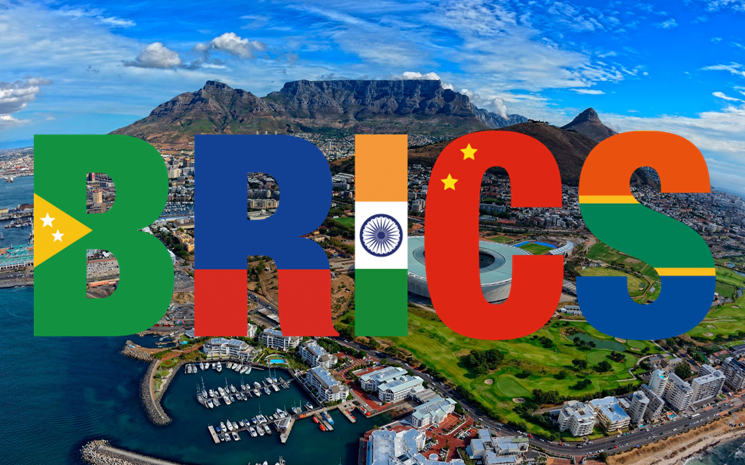Anna-Marie Moulton / The BRICS Chairmanship of South Africa 2018
Anna-Marie Moulton, Plenipotentiary Minister, Councellor for Multilateral Affairs, Embassy of Sout Africa, Rome

Ladies and gentlemen,
Good afternoon!
Dr Ricceri has asked me to share with you some general, basic information to introduce the issue of the incoming Chairmanship of South Africa of BRICS in 2018. I am not going to delve into the history of South Africa’s joining of BRICS as I am sure you are all well-informed on that issue.
During its Chairship, China focused on the fact that the IX BRICS Summit ushered in the second decade of BRICS cooperation, i.e. ten years since the first meeting of the then “BRIC” Foreign/International Relations Ministers in New York in 2006.. 2018 will hold a special significance in the BRICS historical trajectory, as it completes the first decade of BRICS Summits.
To ensure maximum synergy and continuity for BRICS endeavours over the next two years (2017-2018), South Africa is working to strategically align its Chairship in 2018 with that of China in order to plan towards the goals of the next decade of BRICS cooperation. I am sure that you are all informed of the outcomes of the IXth BRICS Summit held in China earlier this year. On that occasion BRICS Leaders committed to redouble efforts to comprehensively deepen BRICS partnership and usher in the second "Golden Decade" of BRICS cooperation.
HOW IS SA PREPARING TO TAKE OVER FROM CHINA FOR THE PERIOD
1 January to 31 December 2018?
It will be the responsibility of President Zuma to host the 10th BRICS Summit and preside over the related calendar of events to be hosted under the South African chairship.
Arrangements for the Summit date and venue are currently being finalised, as are deliberations around a possible theme, logo, substantive and sectoral outcomes and concrete deliverables, the envisioned Summit Declaration and Plan of Action and the overall programme and agenda.
Venues throughout SA should be utilised for the approximately 70-80 meetings under the various tracks/sectors/Ministerial groups.
The SA BRICS Strategy operates at four levels:
-
On the domestic front, to promote and advance our national interests notably through pursuing our core economic priorities as contained in relevant policy documents such as the National Development Plan and as related to addressing the triple challenges of poverty alleviation, job creation, reducing inequality. Therefore seek enhanced trade and investment relations with our BRICS partners.
-
In the regional context, the key objectives are to obtain support from BRICS partners for the promotion of the AU’s Agenda 2063, and ensure synergy among BRICS partners as far as feasible regarding their engagement with Africa; emphasising the exponential growth potential of the Africa-BRICS relationship.
-
South-South cooperation – through BRICS, South Africa continuously endeavours to put the Agenda of the Global South on the forefront, and works to promote the implementation of the 2030 Agenda for Sustainable Development.
-
In the global context, BRICS Leaders are acutely aware of the skewed representation of emerging and developing countries in post-Second World War global governance structures, which also do not correspond to current and emerging geo-strategic realities, and are seeking to address the disparity.
-
At a broad level, the proposals to be explored during 2018 are geared toward generating value-addition for BRICS during South Africa’s tenure as BRICS chair. Furthermore, the activities, new structure and institutions to be put forward are intended to leverage BRICS for the benefit of Africa, to strengthen BRICS multi-level governance, and to build a meaningful interface and exchanges between the various levels/tiers of BRICS.
The exponential institutional development of BRICS has yielded institutions including the New Development Bank (NDB), the Africa Regional Centre (ARC) and the Contingent Reserve Arrangement (CRA), amongst others, all of which are intended to make tangible and impactful contributions toward the development objectives of South Africa, the African continent and the Global South. South Africa will work to consolidate and strengthen these achievements, focusing particularly on the implementation of the BRICS Strategy for Economic Partnership adopted in Ufa in 2015.
The main BRICS activities take place at various levels:
i) The BRICS Leaders meet at the BRICS Summits on an annual basis as well as on the margins of the G20 Summits;
ii) The Ministers of Foreign Affairs/International Relations meet annually on the margins of the United General Assembly Sessions (UNGA) and, as required, the National Security Advisors meet annually, as well as the other Ministerial tracks as outlined in the Summit Action Plans (supported by preparatory Senior Officials meetings); BRICS Deputy Ministers of Foreign Affairs/IR also meet annually to discuss issues in respect of the Middle East and North Africa (MENA) – role of Sherpas and Sous Sherpas;
iii) Track 2 structures, i.e. the BRICS Business Council and BRICS Think Tanks Council;
iv) Track 3 and other structures, including fora for Civil Society, Youth, Academics, Business, Labour as well as Parliament
Approximately 40 separate tracks with approximately 120 meetings per year covering full spectrum of political, security, economic/financial and social sectors.
CONCLUSION
China in 2017 will ensure continuity, coordination and consolidation. This is to be followed through into South Africa's chairship in 2018. This will ensure synergy of BRICS actions.
Outreach dialogue sessions, e.g. the African Union and NEPAD (2013), the Shanghai Cooperation Organisation and Eurasian Economic Union (2015), and BIMSTEC (2016) will be continued.
BRICS will continue to serve as vanguard of the process of realignment in the new global order in cooperation with its partners in the Global South for the collective promotion of the interests of the Global South.
BRICS is a catalyst for foreign policy cooperation, esp. re South-South cooperation, and between emerging markets and developing countries. It has also led through advocacy and policy on key issues such as climate change and the SDGs.
Vastly different today compared to initial conception. It is not constructed in opposition or to counter anything else.


